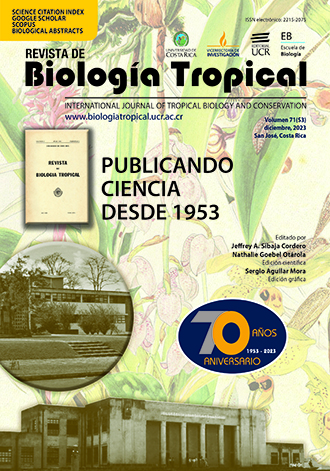Abstract
Introduction: Plant physiology has a global impact in terms of publications given the significance of its research on the performance of plants, whether in their mechanisms, efficiency, adaptability, genetics, and evolution. At the same time, Revista de Biología Tropical (RBT) is one of the most important scientific journals originating from the neotropical region, and this year it reaches its seventy years of creation and continuous publication.
Objective: To identify the topics, provenance, gender equity, and impact of the RBT publications in plant physiology.
Methods: We selected all RBT articles from Web of Science between 2000-2022. From this group of articles, one by one we chose articles with some relation to plant physiology (n= 170). Subsequently, we determined the total number of citations per article by the number of articles per author’s country of affiliation. We calculated the sex equity index per article as the number of female authors among the total authors. Finally, we plotted the frequencies and applied χ2 analysis.
Results: Phytochemistry predominated with 25.3% of the articles, followed by germination-seedlings (20 %), tissue culture-somatic embryogenesis-biotechnology (17.6 %), and stress physiology (10.6 %). The phenology topic stood out with the highest number of citations per article (10.33), followed by phytochemistry (8.98), plant pathology and stress physiology (8.57 and 8.56, respectively), tissue culture (8.33), and ecomorphology (8.09). Most of the publications were from Costa Rica, followed by Colombia and Mexico. Finally, only 38.6 % of the authors that participate in plant physiology publications are women.
Conclusions: Despite the low number of publications on plant physiology in the last 22 years, the RBT follows the international trend on the topics currently investigated and represents an important focus for the dissemination of these topics in Neotropical countries. Finally, plant physiology in the 21st century is still biased towards a low female participation.
References
Allen, G. E. (2017). La ciencia de la vida en el siglo XX. Fondo de Cultura Económica. https://fondodeculturaeconomica.com/Ficha/9786071644794/F
Bianchini, C. L. P. (1955). Las llagas del café en Costa Rica. Revista de Biología Tropical, 3(2), 203–235. https://doi.org/10.15517/rev.biol.trop.1955.28880
López, J. B. (2017). Darwin botánico: origen, desarrollo y perspectivas de la fisiología vegetal. Ciencia Nicolaita, 71. https://doi.org/10.35830/cn.vi71.385
Cheryan, S., Ziegler, S. A., Montoya, A. K., & Jiang, L. (2017). Why are some STEM fields more gender balanced than others? Psychological Bulletin, 143(1), 1–35. https://doi.org/10.1037/bul0000052
Dupar, M. (2020). Informe especial del IPCC sobre el cambio climático y la tierra: ¿Qué significa para América Latina? 1—40 pp. https://idl-bnc-idrc.dspacedirect.org/bitstream/handle/10625/59022/59161.pdf?sequence=1
Echandi, E. (1955). Trunk and stem canker of coffee trees. Revista de Biología Tropical, 3(2), 237–241. https://doi.org/10.15517/rev.biol.trop.1955.28881
Echandi, E. (1957). La Quema de los cafetos causada por Phoma costarricensis n. sp. Revista de Biología Tropical, 5(1), 81–102. https://doi.org/10.15517/rev.biol.trop.1957.28931
Masson-Delmotte, V., Pörtner, H. O., Skea, J., Slade, R., Ferrat, M., Neogi, S., ... & Malley, J. (2020). El cambio climático y la tierra: informe especial del IPCC sobre el cambio climático, la desertificación, la degradación de las tierras, la gestión sostenible de las tierras, la seguridad alimentaria y los flujos de gases de efecto invernadero en los ecosistemas terrestres: resumen para responsables de políticas. 1—40 pp. https://www.ipcc.ch/site/assets/uploads/sites/4/2020/06/SRCCL_SPM_es.pdf
Miflin, B. (2000). Crop improvement in the 21st century. Journal of Experimental Botany, 51(342), 1-8. https://doi.org/10.1093/jexbot/51.342.1
Moose, S. P. & Mumm, R. H. (2008). Molecular plant breeding as the foundation for 21st century crop improvement. Plant Physiology, 147(3), 969-977. https://doi.org/10.1104/pp.108.118232
National Science Foundation. (2014). Integrated postsecondary education data system, 2013, completions survey. National Center for Science and Engineering Statistics: Integrated Science and Engineering Resources Data System (WebCASPAR). https://webcaspar.nsf.gov (Consultado el 15 de julio de 2023).
OpenAI. (2021). ChatGPT: A large language model developed by OpenAI. https://www.openai.com/ (Consultado el 15 de julio de 2023).
R Core Team (2022). R: A language and environment for statistical computing. R Foundation for Statistical Computing, Vienna, Austria. https://www.R-project.org/ (Consultado el 15 de julio de 2023).
Stoet, G. & Geary, D. C. (2018). The Gender-Equality Paradox in Science, Technology, Engineering, and Mathematics Education. Psychological Science, 29(4) 581–593. https://doi.org/10.1177/0956797617741719
Went, F. W. (1957). Fifty years of plant physiology in the USA. American Journal of Botany, 44(1), 105-110. https://doi.org/10.2307/2438353
World Meteorological Organization. (2022). United In Science 2022: A multi-organization high-level compilation of the most recent science related to climate change, impacts and responses. 1—40 pp. https://library.wmo.int/index.php?lvl=notice_display&id=22128
World Meteorological Organization. (2023). State of the Climate in Latin America and the Caribbean. Geneva, Switzerland. 1—35 pp. https://library.wmo.int/index.php?lvl=notice_display&id=22309
##plugins.facebook.comentarios##

This work is licensed under a Creative Commons Attribution 4.0 International License.







